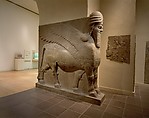Human-headed winged bull (lamassu)
Not on view
From the ninth to the seventh century B.C., the kings of Assyria ruled over a vast empire centered in northern Iraq. The great Assyrian king Ashurnasirpal II (r. 883–859 B.C.), undertook a vast building program at Nimrud, ancient Kalhu. Until it became the capital city under Ashurnasirpal, Nimrud had been no more than a provincial town.
The new capital occupied an area of about nine hundred acres, around which Ashurnasirpal constructed a mudbrick wall that was 120 feet thick, 42 feet high, and five miles long. In the southwest corner of this enclosure was the acropolis, where the temples, palaces, and administrative offices of the empire were located. In 879 B.C. Ashurnasirpal held a festival for 69,574 people to celebrate the construction of the new capital, and the event was documented by an inscription that read: "the happy people of all the lands together with the people of Kalhu—for ten days I feasted, wined, bathed, and honored them and sent them back to their home in peace and joy."
The so-called Standard Inscription that ran across the surface of most of the reliefs described Ashurnasirpal's palace: "I built thereon [a palace with] halls of cedar, cypress, juniper, boxwood, teak, terebinth, and tamarisk [?] as my royal dwelling and for the enduring leisure life of my lordship." The inscription continues: "Beasts of the mountains and the seas, which I had fashioned out of white limestone and alabaster, I had set up in its gates. I made it [the palace] fittingly imposing." Among such stone beasts is the human-headed, winged bull pictured here. The horned cap attests to its divinity, and the belt signifies its power. The sculptor gave these guardian figures five legs so that they appear to be standing firmly when viewed from the front but striding forward when seen from the side. Lamassu protected and supported important doorways in Assyrian palaces.
Due to rights restrictions, this image cannot be enlarged, viewed at full screen, or downloaded.
This artwork is meant to be viewed from right to left. Scroll left to view more.



